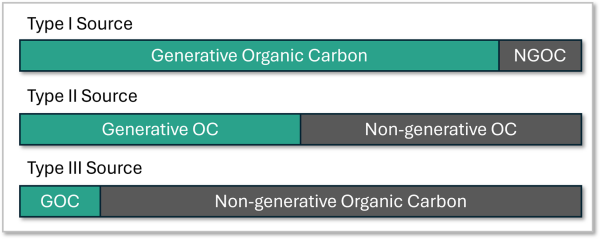Execution time: 1.0843 seconds, Peak memory usage: 10 MB

Senior Geochemist/Basin Modeller
In petroleum geochemistry, a source rock is classified as an interval of rock that contains sufficient organic matter of the right type that has the potential to generate, or has already generated, commercial quantities of hydrocarbons.
When conducting an assessment of a play or prospects there are three main source-rock related exploration objectives that geochemists/petroleum system modellers investigate:
· How much organic carbon (Corg) is there?
· What is the thermal maturity level of the organic material in the rock?
· What type of organic matter is present in the source rock?
Focusing on the initial investigation goal, the first screening analysis for any source rock is its organic richness, measured and reported as total organic carbon (TOC). The TOC is a measure, at present day, of the amount of organic carbon present in a sediment sample (TOCpd).
Taken alone, TOC is a quantitative measure (weight per cent TOC, wt%) of the organic carbon present in the analysed sample. It does not provide information regarding a rock's generation potential, as this requires an assessment of the TOC composition (Jarvie, 1991).
Not all organic carbon captured in the total organic carbon value can generate hydrocarbons. TOC comprises three components (Figure 1):
· EOM – Extractable organic matter carbon is carbon contained in already formed oil & gas stored in the rock matrix.
· GOC – Generative organic carbon is carbon contained in the kerogen (yield potential), which converts to oil and/or gas given appropriate temperature and time conditions.
· NGOC – Non-generative organic carbon is carbon also in the kerogen that has no potential to generate oil or gas.

Fig 1. Component model for total organic carbon. The carbon constituents located in either a sediment's kerogen or matrix as oil and gas already formed.
When evaluating source rocks, it is important to consider the TOC values and the TOC composition. Jarvie (1991) demonstrated that determining the organic quantity, along with the kerogen type (Figure 2), from Rock-Eval or visual kerogen assessment, provides an improved evaluation of source potential.

Fig 2. Kerogen-type, component model for the kerogen-associated organic carbon.
As TOC values vary throughout a source rock due to organofacies differences, preservation effects, thermal maturity, and even sample type (cuttings[1] vs. core chips), considerable debate exists in the literature over the TOC cutoff values required to describe and classify source rock potential (Tissot & Welte, 1984; Espitalié & Bordenave, 1993; Cornford, 1998).
Peters et al. (2005), utilising values from Tissot & Welte (1984), reported generally accepted criteria for interpreting the quantity, quality and thermal maturity of organic matter in a source rock. The TOC quantity fields presented ranged from poor to excellent (Table 1):
[1] Li et al. (2010) documented variations in cutting TOC values through the Fayetteville and Chattanooga shales, illustrating mixing effects. An overlying organic-lean sediment will dilute an organic rich sample often for 10 to 40 ft (3 to 12 m).
Table 1: Total organic carbon descriptive categories used to describe the amount of organic matter associated with a sample, not the hydrocarbon source potential. The table contains both Ken Peters originally presented (2005) and the revised (2023, pers. comm.) wt% values which are appropriate for both clastic and carbonate source lithologies. Note the 2005 work was based on the classic text by Tissot & Welte (1984).
However, following the results of hydrous pyrolysis work conducted by Lewan (1987), who, while working on primary migration in North American shales, noted that rocks with <2.5 wt.% TOC are incapable of establishing a continuous bitumen network to facilitate expulsion, TOC cutoff values were revised upwards (Peters, 2023, pers. comm.) (Table 1).
The revised TOC cutoffs also align with source rock generative potential mass balance sensitivity work, reported in Peters et al. (2005), which implied that regardless of a sample's initial hydrogen index value, expulsion efficiencies will be low for samples containing less than 1-2 wt.% initial TOC.
Note that, where appropriate, auto-artefact templates using TOC as either an axis property or palette property in IGI Ltd.’s geochemical p:IGI+ software have been updated to reflect Ken Peters' (2023, pers. comm.) TOC scale. Information is provided in an artefact's information box accessible from the blue ‘i’ symbol.
References:
Carvajal-Ortiz, H. & Gentzis, T. (2015). Critical considerations when assessing hydrocarbon plays using Rock-Eval pyrolysis and organic petrology data: Data quality revisited. Int. J. Coal Geol., 152(A), pp. 113-122.
Cornford, C. (1998) ‘Source Rocks and Hydrocarbons of the North Sea’ in K.W. Glennie (ed.) Petroleum Geology of the North Sea, Basic concepts and recent advances. UK: Blackwell Science, pp.376-462.
Espitalié, J. and Bordenave, M.L. (1993) ‘Rock-Eval Pyrolysis’ in M.L. Bordenave (ed.) Applied Petroleum Geochemistry. Paris: Éditions Technip, pp. 235-262.
Jarvie, D.M. (1991) ‘Total Organic Carbon (TOC) Analysis’, in R.K. Merrill (ed.) Treatise of Petroleum Geology, Handbook of Petroleum Geology, Source and Migration Processes and Evaluation Techniques. Tulsa: AAPG Press, pp. 113-118.
Lewan, M.D. (1987) ‘Petrographic study of primary petroleum migration in the Woodford Shale and related rock units’, in B. Doligez (ed.) Migration of Hydrocarbons in Sedimentary Basins. Paris: Éditions Technip, pp. 113-130.
Li, P., Ratchford, M. E. and Jarvie, D. M. (2010). Geochemistry and thermal maturity analysis of the Fayetteville Shale and Chattanooga Shale in the western Arkoma
Basin of Arkansas. Arkansas Geological Survey, Information Circular, 40, pp. 58.
Peters. K., Walters, C.C. and Moldowan, M. (2005). The Biomarker Guide, Vol 1: Biomarkers and Isotopes in the Environment and Human History. 2nd Edition. UK: Cambridge University Press.
Peters. K. (2023). Personal communications on the topic of TOC cutoffs.
Tissot, B.P. & Welte, D.H. (1984). Petroleum Formation and Occurrence. 2nd Edition. Berlin: Springer-Verlag.